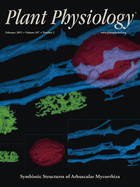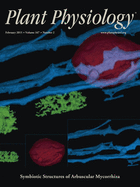
Cover image

On the Cover: The cover depicts symbiotic arbuscular mycorrhizal (AM) fungus Rhizophagus irregularis in Lotus japonicus roots. AM symbiosis is a mutualistic interaction that supplies the plant with inorganics, including phosphate and nitrate, and the fungus with photosynthetic products. The fungus enters and affects hyphae (blue) within the host root, forming symbiotic vesicles (red) and arbuscules (green) to facilitate material exchange between the host and the fungus. Takeda et al. (pp. 545–557) describe a role for the phytohormone GA in AM symbiosis, including an up-regulation of GA synthesis and its accumulation in the root. The fungal structures shown were stained with Wheat Germ Agglutinin-Alexafluor 594 for confocal microscopy, and images were rendered to generate these three-dimensional projections. Cover image credits: Naoya Takeda (National Institute for Basic Biology, Division of Symbiotic Systems).
Volume 167, Issue 2, February 2015
ON THE INSIDE
On the Inside
SCIENTIFIC CORRESPONDENCE
OPEN ALL NIGHT LONG: The Dark Side of Stomatal Control
Isolation of Arabidopsis mutants that maintain stomata open all night long credits the existence of dedicated regulators for stomatal closure in darkness.
UPDATES
Regulation of Specialized Metabolism by WRKY Transcription Factors
WRKY transcription factors play an essential role in regulating the biosynthesis of plant-specialized metabolites.
Articles
BIOCHEMISTRY AND METABOLISM
Pepper Heat Shock Protein 70a Interacts with the Type III Effector AvrBsT and Triggers Plant Cell Death and Immunity
A pepper heat shock protein acts as a positive regulator of plant cell death and immunity signaling in response to heat stress and microbial pathogens.
The Exosome and Trans-Acting Small Interfering RNAs Regulate Cuticular Wax Biosynthesis during Arabidopsis Inflorescence Stem Development
The exosome and small RNAs control Arabidopsis cuticular wax biosynthesis.
Down-Regulation of Kelch Domain-Containing F-Box Protein in Arabidopsis Enhances the Production of (Poly)phenols and Tolerance to Ultraviolet Radiation
Kelch repeat F-box proteins physically interact with phenylpropanoid biosynthetic enzymes, and regulate the production of (poly)phenolics and plant tolerance to ultraviolet irradiation.
Two Activities of Long-Chain Acyl-Coenzyme A Synthetase Are Involved in Lipid Trafficking between the Endoplasmic Reticulum and the Plastid in Arabidopsis
Lipid reassembly is a key step in the transfer of cytosolic lipid precursors to the plastid.
CELL BIOLOGY
PECTIN METHYLESTERASE48 Is Involved in Arabidopsis Pollen Grain Germination
Modifying homogalacturonans in the intine cell wall during maturation of the pollen grain is central for proper germination.
CESA TRAFFICKING INHIBITOR Inhibits Cellulose Deposition and Interferes with the Trafficking of Cellulose Synthase Complexes and Their Associated Proteins KORRIGAN1 and POM2/CELLULOSE SYNTHASE INTERACTIVE PROTEIN1
The compound CESTRIN reduces cellulose content and inhibits the trafficking of CESA in Arabidopsis hypocotyls.
DEVELOPMENTALLY REGULATED PLASMA MEMBRANE PROTEIN of Nicotiana benthamiana Contributes to Potyvirus Movement and Transports to Plasmodesmata via the Early Secretory Pathway and the Actomyosin System
Virus movement in tobacco depends on interactions between tobacco and viral movement proteins and on their traffic to plasmodesmata.
ECOPHYSIOLOGY AND SUSTAINABILITY
A Wheat CCAAT Box-Binding Transcription Factor Increases the Grain Yield of Wheat with Less Fertilizer Input
The transcription factor TaNFYA-B1 is up-regulated by low-nitrogen and low-phosphorus treatment in wheat seedlings, and overexpressing this gene increases the grain yield of wheat under differing nitrogen and phosphorus supply levels.
GENES, DEVELOPMENT, AND EVOLUTION
Transcriptional, Posttranscriptional, and Posttranslational Regulation of SHOOT MERISTEMLESS Gene Expression in Arabidopsis Determines Gene Function in the Shoot Apex
A homeobox gene key for plant development is regulated at the transcriptional, posttranscriptional, and posttranslational levels.
The naked endosperm Genes Encode Duplicate INDETERMINATE Domain Transcription Factors Required for Maize Endosperm Cell Patterning and Differentiation
A duplicated pair of transcription factors control cell patterning and cell differentiation in maize endosperm development.
MEMBRANES, TRANSPORT, AND BIOENERGETICS
High Light-Dependent Phosphorylation of Photosystem II Inner Antenna CP29 in Monocots Is STN7 Independent and Enhances Nonphotochemical Quenching
Phosphorylation of a monomeric antenna protein correlates with increased photoprotective energy dissipation in monocots and is controlled by distinct enzymes compared with trimeric major antennae.
FLAVODIIRON2 and FLAVODIIRON4 Proteins Mediate an Oxygen-Dependent Alternative Electron Flow in Synechocystis sp. PCC 6803 under CO2-Limited Conditions
Two iron-bound flavidoxin-domain proteins mediate an oxygen-dependent alternative electron flow in the cyanobacterium Synechocystis under CO2-limited conditions.
PHOTOSYSTEM II PROTEIN33, a Protein Conserved in the Plastid Lineage, Is Associated with the Chloroplast Thylakoid Membrane and Provides Stability to Photosystem II Supercomplexes in Arabidopsis
The study of a previously undescribed protein shows its involvement in the maintenance of the photosystem II light-harvesting supercomplex.
SIGNALING AND RESPONSE
Protein Phosphatase 2A Holoenzyme Is Targeted to Peroxisomes by Piggybacking and Positively Affects Peroxisomal β-Oxidation
Protein phosphatase 2A targets peroxisomes and positively affects fatty acid oxidation.
Arabidopsis Receptor of Activated C Kinase1 Phosphorylation by WITH NO LYSINE8 KINASE
Phosphorylation of a scaffold protein negatively regulates its function by affecting protein stability.
Thermoperiodic Control of Hypocotyl Elongation Depends on Auxin-Induced Ethylene Signaling That Controls Downstream PHYTOCHROME INTERACTING FACTOR3 Activity
Antiphase light and temperature cycles disrupt an auxin-ethylene-induced signaling cascade, leading to reduced hypocotyl elongation.
Comprehensive Gene Expression Analysis of Rice Aleurone Cells: Probing the Existence of an Alternative Gibberellin Receptor
A single mechanism exists of gibberellin perception for gene expression in rice aleurone cells.
Gibberellins Interfere with Symbiosis Signaling and Gene Expression and Alter Colonization by Arbuscular Mycorrhizal Fungi in Lotus japonicus
Gibberellin signaling is enhanced by, and exerts positive and negative effects on, arbuscular mycorrhiza development by interfering with symbiotic signaling and gene expression.
SYSTEMS AND SYNTHETIC BIOLOGY
The Regulation of Photosynthetic Structure and Function during Nitrogen Deprivation in Chlamydomonas reinhardtii
Nitrogen deprivation induces orderly, multilevel down-regulation of the photosynthetic apparatus, energy capture, and carbon fixation.
The Benefits of Photorespiratory Bypasses: How Can They Work?
The benefits of a photorespiratory bypass depend on its metabolic and chloroplast membrane diffusion properties.
Genome-Based Metabolic Mapping and 13C Flux Analysis Reveal Systematic Properties of an Oleaginous Microalga Chlorella protothecoides
Integrated flux balance analysis accurately reconstructs phototrophic and heterotrophic metabolism in Chlorella protothecoides.


